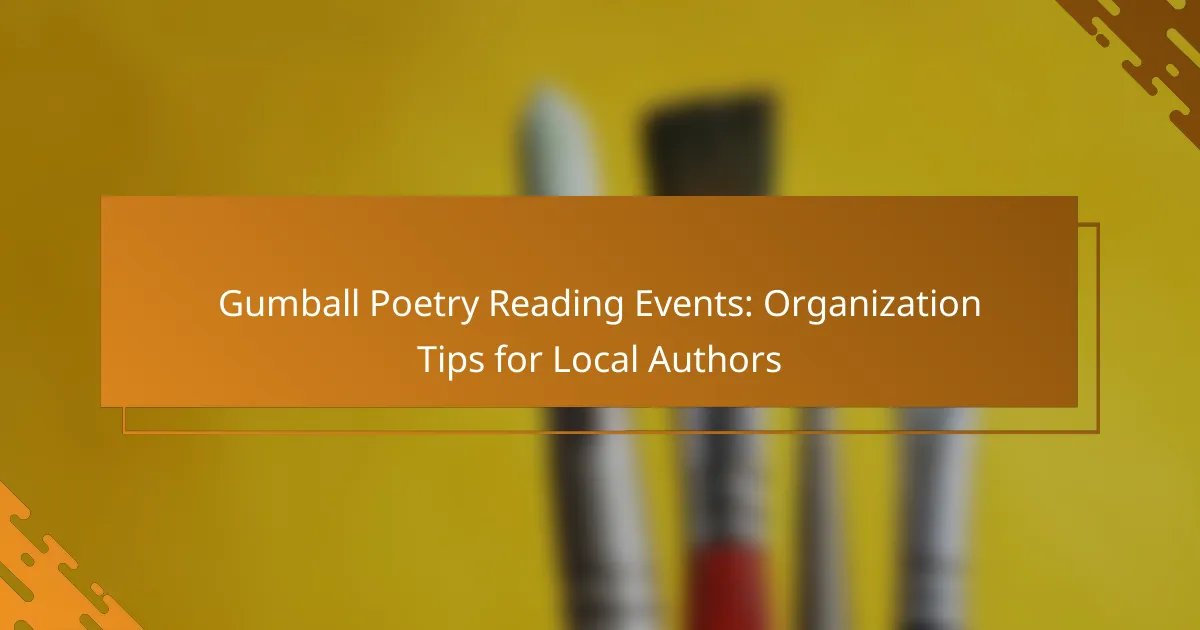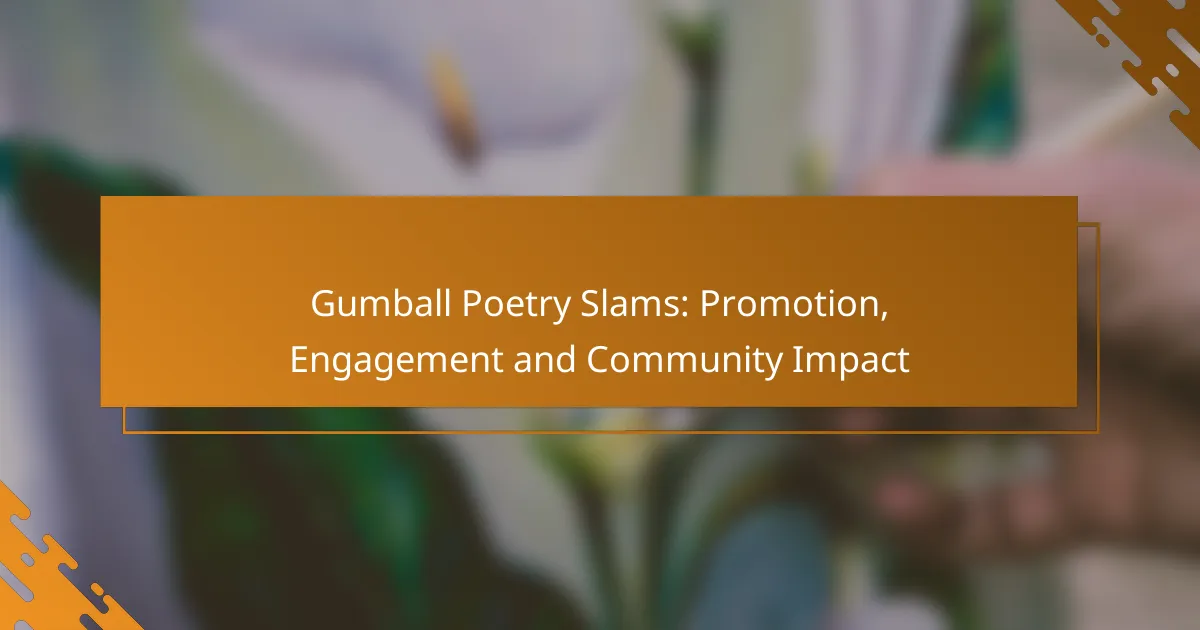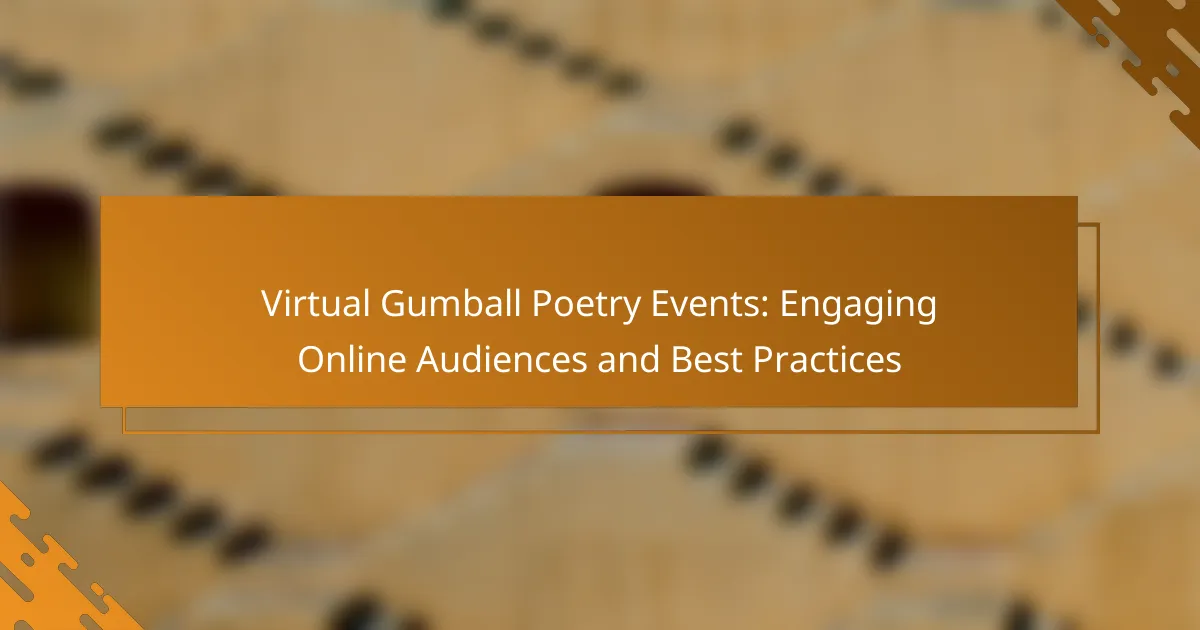Organizing Gumball Poetry Reading events in New York City requires careful planning to create an engaging atmosphere for local authors and attendees. Key elements include selecting a suitable venue, promoting the authors effectively, and providing interactive experiences that foster community engagement. By utilizing the right materials and a mix of promotional strategies, you can ensure a successful and memorable event for everyone involved.
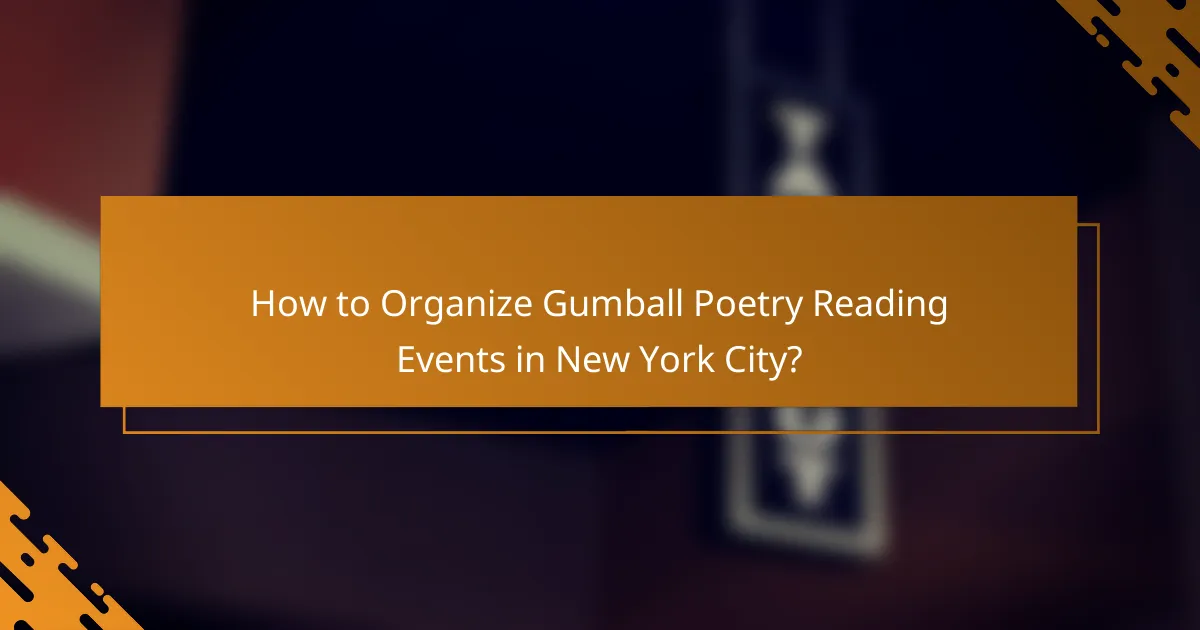
How to Organize Gumball Poetry Reading Events in New York City?
To organize Gumball Poetry Reading events in New York City, focus on selecting an engaging venue, promoting local authors effectively, and creating an interactive experience for attendees. These elements are crucial for attracting participants and ensuring a memorable event.
Venue selection criteria
Choosing the right venue is essential for a successful Gumball Poetry Reading event. Look for spaces that are accessible, have a cozy atmosphere, and can accommodate your expected audience size, typically ranging from 20 to 100 people. Consider locations like local cafes, community centers, or bookstores that support literary events.
Ensure the venue has necessary amenities such as seating, sound equipment, and good lighting. Additionally, check if the venue is available on your desired date and inquire about rental costs, which can vary widely in NYC.
Promotional strategies for local authors
Effective promotion is key to attracting attendees to your Gumball Poetry Reading. Utilize social media platforms like Instagram and Facebook to create event pages and share engaging content, such as author spotlights or sneak peeks of the poetry to be read. Collaborate with local literary groups and influencers to expand your reach.
Consider distributing flyers in local bookstores, libraries, and community boards. Email newsletters targeting poetry enthusiasts can also be a valuable tool. Aim for a mix of online and offline strategies to maximize visibility.
Engagement techniques for attendees
To keep attendees engaged during the Gumball Poetry Reading, incorporate interactive elements such as Q&A sessions with authors or audience participation in readings. Encourage attendees to share their thoughts on the poems, fostering a sense of community and connection.
Offering refreshments can enhance the experience, making the event feel more inviting. Additionally, consider providing small tokens, like bookmarks or poetry-themed giveaways, to create lasting memories and encourage future participation.

What are the essential materials for a successful poetry reading?
Essential materials for a successful poetry reading include the right equipment and printed materials that enhance the experience for both the author and the audience. Proper preparation ensures that the event runs smoothly and engages participants effectively.
Required equipment for readings
Key equipment for poetry readings typically includes a microphone, speakers, and a sound system to ensure that all attendees can hear clearly. If the venue is large, consider using a portable PA system to amplify the voice of the reader.
Additionally, having a podium or a comfortable space for the reader to stand can help create a professional atmosphere. A timer can also be useful to keep track of reading durations, especially if multiple authors are participating.
Printed materials for participants
Printed materials such as programs or flyers are essential for informing attendees about the event schedule and featured poets. These materials can include bios, poetry excerpts, and any relevant information about the venue or sponsors.
Providing copies of the poems being read can enhance audience engagement, allowing them to follow along. Consider printing on quality paper to give a polished look, and ensure that the font is legible from a distance.
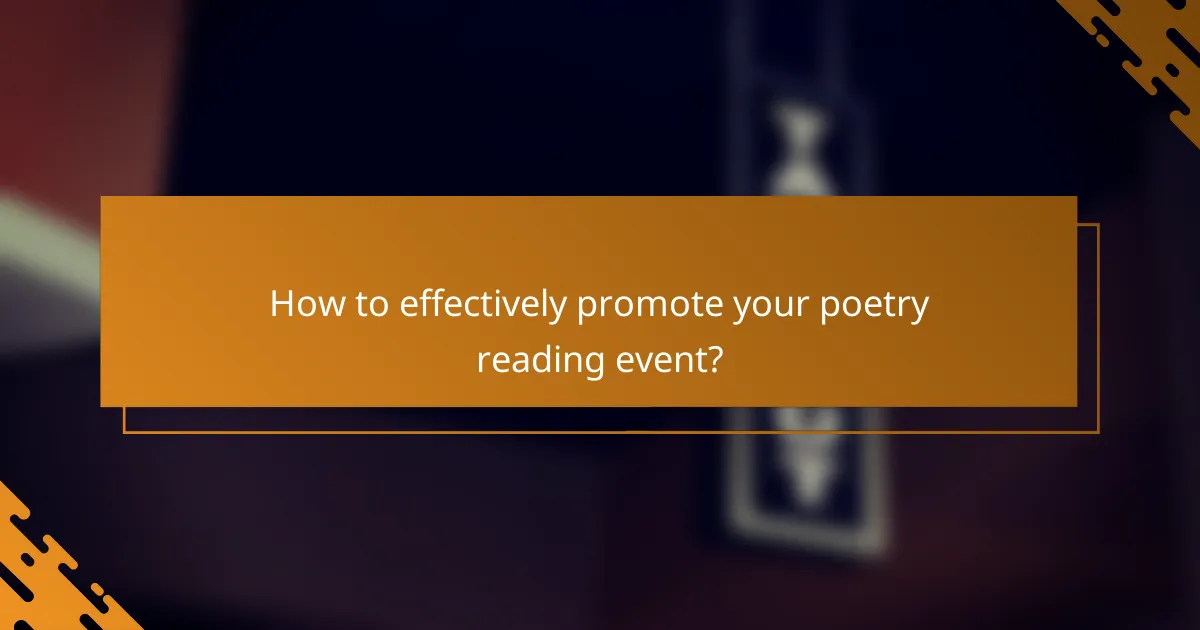
How to effectively promote your poetry reading event?
To effectively promote your poetry reading event, leverage a mix of online and offline strategies that engage your target audience. Focus on building a community around your event through consistent messaging and collaboration with local entities.
Social media marketing tactics
Utilize platforms like Facebook, Instagram, and Twitter to create buzz around your poetry reading. Share engaging content such as behind-the-scenes preparations, poet spotlights, and event countdowns to attract attention.
Consider using targeted ads to reach local poetry enthusiasts. Set a budget that aligns with your goals, and experiment with different ad formats, such as event pages or promotional posts, to see what resonates best with your audience.
Collaborations with local bookstores
Partnering with local bookstores can significantly enhance your event’s visibility. Approach bookstores to host your reading or display promotional materials, such as flyers or bookmarks, to attract their customers.
Additionally, consider organizing joint events, such as book signings or workshops, to draw in a larger crowd. This not only benefits your poetry reading but also strengthens community ties and encourages local support for the arts.
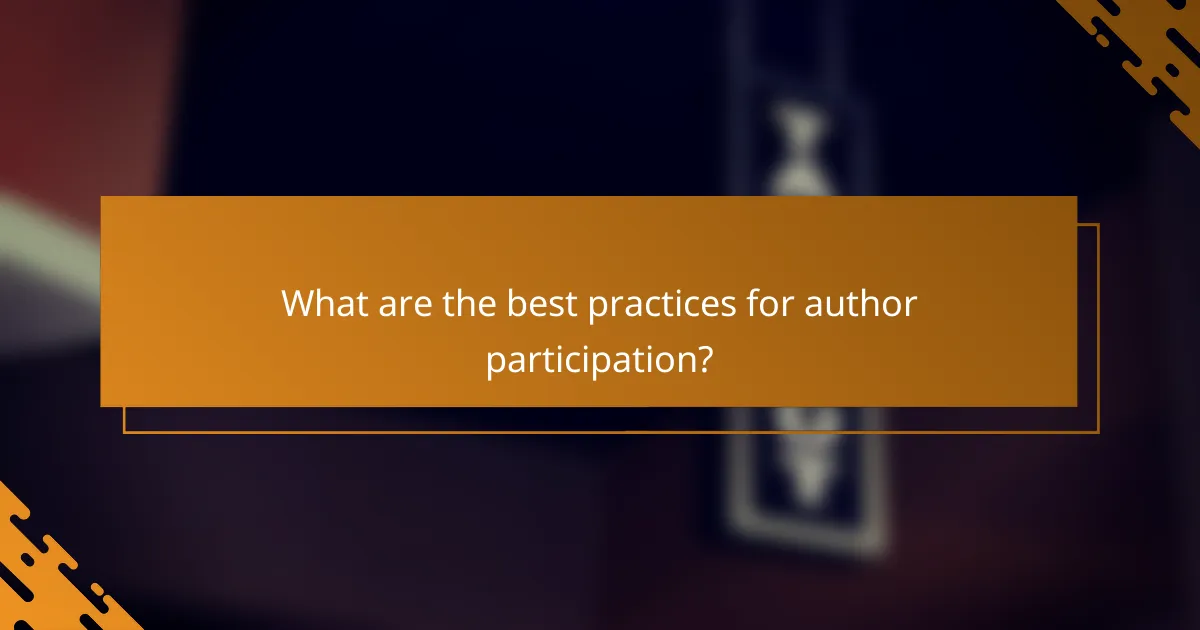
What are the best practices for author participation?
Effective author participation in gumball poetry reading events involves clear communication, preparation, and engagement with the audience. Local authors should focus on creating a welcoming atmosphere that encourages creativity and connection.
Inviting local authors
When inviting local authors, consider reaching out to a diverse group to represent various styles and backgrounds. Use social media, community boards, and local literary organizations to spread the word and attract participants.
Establish a clear invitation process, outlining expectations such as reading length, themes, and any specific requirements. This helps authors prepare and ensures a smooth event flow.
Preparing authors for readings
Preparation is key for authors participating in readings. Encourage them to rehearse their pieces to build confidence and ensure they stay within time limits, typically around five to ten minutes per reading.
Provide authors with tips on engaging the audience, such as making eye contact and using expressive voice modulation. Consider hosting a pre-event workshop to help authors practice and receive constructive feedback.

How to create an engaging atmosphere for poetry readings?
Creating an engaging atmosphere for poetry readings involves setting the right mood and fostering a connection between the authors and the audience. Consider elements like lighting, seating arrangements, and sound to enhance the overall experience.
Setting up the venue
Choosing the right venue is crucial for a successful poetry reading. Look for spaces that are intimate and comfortable, such as local cafes, community centers, or libraries. Ensure the seating is arranged to promote interaction, with options for both seated and standing audiences.
Pay attention to lighting and acoustics. Soft, warm lighting can create a cozy ambiance, while good acoustics ensure that every word is heard clearly. If possible, test the sound system beforehand to avoid technical issues during the event.
Incorporating audience interaction
Engaging the audience during poetry readings can significantly enhance the experience. Consider incorporating interactive elements such as Q&A sessions, open mic opportunities, or even brief writing prompts that allow attendees to express their thoughts or feelings about the readings.
Encourage feedback and discussion after each reading. This not only makes the event more dynamic but also helps authors connect with their audience on a deeper level. Simple gestures, like inviting applause or reactions, can make the atmosphere more lively and inclusive.

What are the common challenges in organizing poetry readings?
Organizing poetry readings often involves challenges such as managing time effectively and dealing with low attendance. These issues can impact the overall success of the event and the experience for both authors and attendees.
Managing time effectively
Effective time management is crucial for a successful poetry reading. Each poet should have a clear time limit, typically ranging from 5 to 10 minutes, to ensure that all participants have an opportunity to present their work without the event running excessively long.
Consider creating a detailed schedule that includes time for introductions, readings, and audience interaction. Use timers or appoint a timekeeper to help keep everyone on track. This will help maintain a smooth flow and keep the audience engaged.
Dealing with low attendance
Low attendance can be disheartening for local authors, but there are strategies to boost turnout. Promoting the event through social media, local community boards, and partnerships with local businesses can help attract more participants.
Offering incentives, such as refreshments or a small prize for audience engagement, can also encourage attendance. Additionally, consider scheduling readings during popular local events or weekends to maximize visibility and participation.
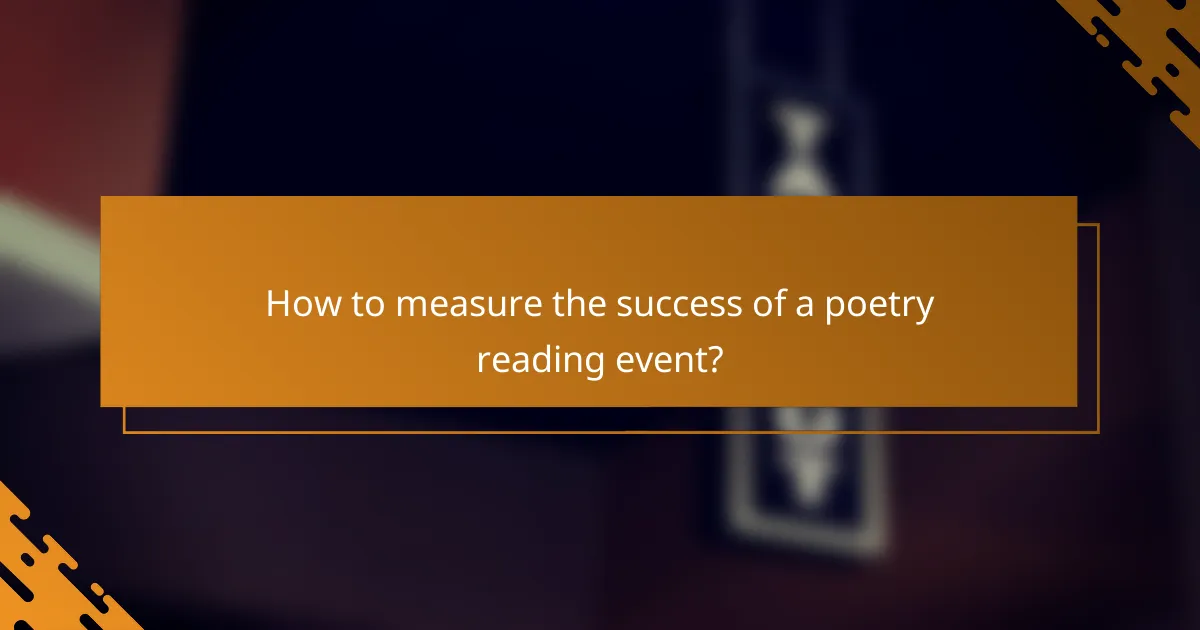
How to measure the success of a poetry reading event?
Measuring the success of a poetry reading event involves assessing both qualitative and quantitative factors. Key indicators include audience engagement, feedback from attendees, and attendance numbers, which together provide a comprehensive view of the event’s impact.
Feedback collection methods
Collecting feedback is crucial for understanding attendees’ experiences at poetry readings. Use methods such as post-event surveys, comment cards, or informal discussions to gather insights. Aim for a mix of quantitative questions, like rating the event on a scale, and qualitative prompts that allow for open-ended responses.
Consider incentivizing feedback by offering a small prize or discount on future events. This can increase participation rates and provide more valuable data on what worked well and what could be improved.
Analyzing attendance data
Attendance data is a vital metric for evaluating the success of your poetry reading. Track the number of attendees compared to your expectations and previous events. Look for patterns, such as peak attendance times or demographic trends, to inform future planning.
Utilize tools like ticket sales platforms or social media analytics to gather this information. A simple comparison of attendance figures across events can reveal whether your promotional strategies are effective or if adjustments are needed to attract a larger audience.
